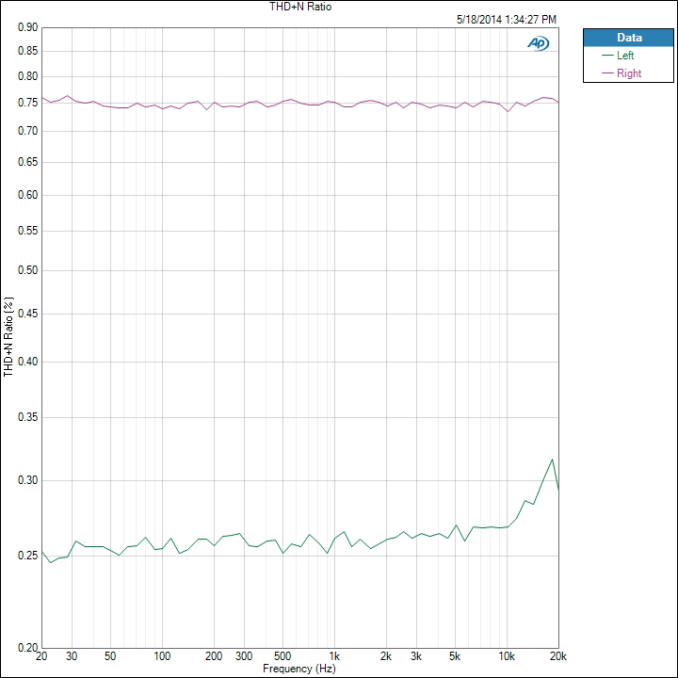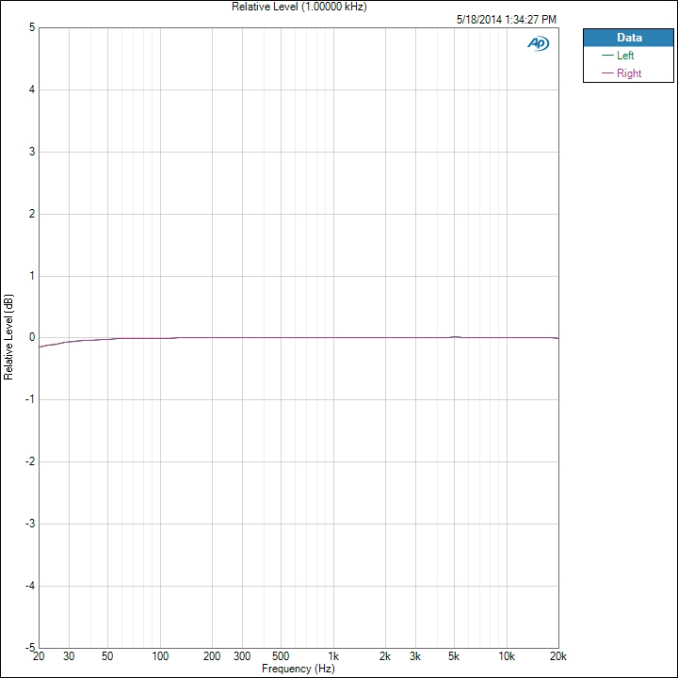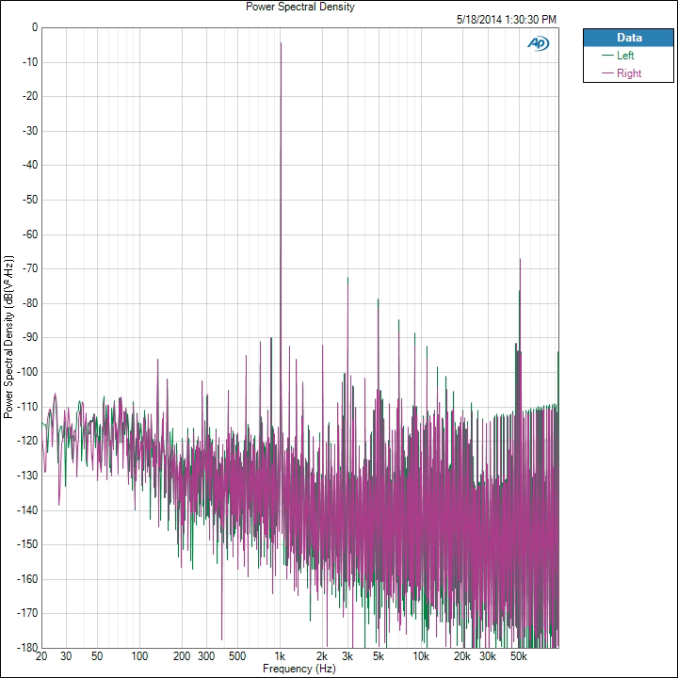Smartphone Audio Testing - HTC One M8 and Samsung Galaxy S5
by Chris Heinonen on June 2, 2014 8:00 PM EST- Posted in
- Smartphones
- Mobile
- Testing
- Audio Precision
Samsung Galaxy S5 Audio Testing
Compared to the HTC One M8, the Samsung Galaxy S5 has a worse audio system. It only puts out around 20% of the wattage of the HTC One M8, making it less likely to be able to drive every headphone to a reasonable level. The THD+N on the 15 Ohm load is lower with the Samsung, but it is putting out half the power and under a quarter of the watts of the HTC One M8. If you drop the HTC One M8 down a single volume level it will still be far more powerful but likely have lower THD+N.
Dynamic Range is almost identical between the two phones, and close enough that you will not hear a difference. Crosstalk is a major difference as the Samsung is -20 dB worse here than the HTC One M8. You are likely to hear sound from one channel in the other ear. This can reduce the size of the stereo image and present the music as being more unfocused.
The relative level is better on the Samsung but I don’t think anyone will be able to hear the difference between the two.
| 15 Ohm | 33 Ohm | 150 Ohm | 330 Ohm | |
| Dynamic Range | 91.877 dB | 91.921 dB | 92.113 dB | 91.985 dB |
| THD+N | 0.1457% | 0.0505% | 0.0102% | 0.0103% |
| Crosstalk (L) | -38.347 dB | -44.767 dB | -57.666 dB | -64.503 dB |
| Crosstalk (R) | -38.329 dB | -44.804 dB | -57.704 dB | -64.485 dB |
| Output Power | 22.31 mW | 10.63 mW | 2.602 mW | 1.194 mW |
| Output Voltage | 577.3 mVrms | 592.4 mVrms | 624.7 mVrms | 627.8 mVrms |
| Relative Level (20Hz - 20kHz) | ±0.081 dB | ±0.081 dB | ±0.082 dB | ±0.082 dB |
Compared to the HTC, the THD+N on the S5 is much higher. Whereas the HTC only passes 0.2% around 20kHz, the S5 is past 0.25% for the entire time on the stepped frequency sweep. The Right channel shows higher THD+N values than the left channel, while the HTC is identical in both channels. I checked the graph for every impedance load and they all look identical to this so it isn’t an error in measurement.
Unlike the HTC, the frequency response of the Galaxy S 5 is flat out to 20kHz. It has the same meaningless drop at 20Hz as well. Again I don’t think anyone will hear the difference, but the Samsung is better.
This chart shows that the S5 favors odd-order distortion over even-order distortion. The 2nd and 4th harmonics are below -90dB and -100dB respectively, while the 3rd and 5th order harmonics are each over 20dB higher. Most people find odd-order distortion harsher than even-order distortion.
Conclusions
Unlike the HTC One M8, there are no sound modes to play around with in the Galaxy S 5. With these two flagship phones for 2014, the HTC One M8 is packing the superior audio system. Is has a more powerful amplifier at all levels, lower crosstalk, and lower THD+N. The relative frequency response is worse but not by an audible amount.
The HTC One M8 will be more versatile by supporting a wider selection of headphones at more listening levels. There will be headphones that the Samsung is not able to drive to reasonable listening levels that the HTC One M8 will have no issues with.













78 Comments
View All Comments
cheinonen - Wednesday, June 4, 2014 - link
It doesn't matter if they're using the same DAC. They provide no line-out functionality so you're subject to the limitations of the amplifier driving the headphone jack. In this case, the amplifier that HTC has chosen to use is far more powerful, with less noise and crosstalk, than the one that Samsung chose. It's impossible to isolate a single component, like the DAC, and expect everything that uses it to have identical performance. It's part of a system and everything else in the system has to perform at a level for it to function right.For the subjective testing, I'll leave that to Anand and Joshua who are spending far more hands-on time with the phones than I am. I'll run the numbers and provide a straight analysis of them.
theduckofdeath - Thursday, June 5, 2014 - link
The reason they need subjective listening is because they insist on using hyperbole to differentiate devices. Based on data output from a metering device.Here's an example why actual human testing is needed:
http://www.tomshardware.com/reviews/high-end-pc-au...
Lambasting something as horribly bad without actually making a real life comparison is a typical nerd error. "The numbers are superior, therefore it must sound superior!". The human ear is really limited in what sounds it can pick up. It's not nearly as accurate as Chris appears to think as very few adults, especially those who frequently listen to headphone music, can hear anything even near 20kHz.
synaesthetic - Saturday, June 7, 2014 - link
Sighted listening produces biased results. Measurements are verifiable, demonstrable and repeatable. Subjective listening tests are just that, subjective and thus useless to anyone but the person doing the listening.This is why I appreciate actual data. I can look at a frequency response graph for a headphone and compare it to another headphone I know I like, and I can get an idea how the other headphone sounds without having to decide which subjective listener's ears I'm going to trust.
theduckofdeath - Wednesday, June 11, 2014 - link
The point I made is, measuring things that are probably not even audible to a human being ,and use that as a review for audio quality is pretty pointless. Then you've really missed the whole point of being a product review site for devices intended for regular human use. :)apertotes - Tuesday, June 10, 2014 - link
but you did not answer. Which Galaxy S5 did you test?Jimster480 - Tuesday, June 10, 2014 - link
The M8 sounds alot better than the GS5. Its been determined so many different times. I own an M8 aswell and I have to say the sound quality is like none other.edzieba - Tuesday, June 3, 2014 - link
I'd like to see Output Impedance measurements. If that heads north of 2ohm, then that's a good red flag for things having gone seriously wrong.Rezurecta - Tuesday, June 3, 2014 - link
No it is not. Where did you get this misinformation?synaesthetic - Saturday, June 7, 2014 - link
Output impedance is THE single most important factor for how a given driver will sound with a given analog output. When the 1/8th Rule is violated, the driver will lose some or all of its electrical dampening. This usually tends to kill bass and warp the rest of the headphone's frequency response, making it sound abnormal.The fact that most manufacturers, reviewers and the like never bother to check output impedance is very, very annoying and makes headphone selection needlessly complicated. Very low-impedance headphones, such as Ultimate Ears IEMs, will not sound "normal" out of a source with an output impedance over 1.6 ohms.
Properly designed amplifier sections should have an output impedance as close to zero as possible so that they work properly with all headphones.
Jimster480 - Tuesday, June 10, 2014 - link
Well my M8 has worked fine with 5 different headphones I have tried it with. 3 Different sets of IEM's (Sony Earbuds, Skullcandy IEM's, and Bose IEM's). And a Sony over the ear aswell as a Panasonic RP-HT360 and it sounds very clear and rich on every set. No set is too loud nor does the sound reproduction sound incorrect or flawed.